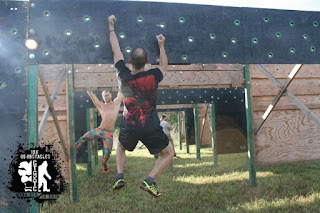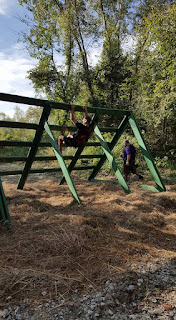CTG
XTC Mega Race Review
I almost didn't go to this race because it was schedule so close to
the Obstacle Course Racing World Championship. I didn't want to be
hurt or too sore before my trip to Canada. But, I'm really glad I
participated in the CTG XTC 10K Mega OCR. It was one of the best
races I've ever ran. In addition to the course being fun and
difficult, it was like the closing festival for obstacle course
racing in mid-America. Hosted by
Conquer the Gauntlet and
Xtreme Timber Challenge at KC Timber Challenge in Bonner Springs, Kansas.
I ran in the elite wave so I got there early. One by one the Conquer
the Gauntlet pro-team started arriving. This was like the who's who
of OCR in mid-America. Those racing stars who were not at the Spartan
World Championships in Tahoe were at the Mega Race.
The race started with a shotgun blast. We ran for nearly 3miles
before we reached the real Gauntlet. We had to climb the steps of
the zipline tower and ring a bell.
First obstacle, The Log Cross
Rope climb up a bluff.
Bus Crawl.
More bus action.
The Quad Burner.
Another climb.
The Ankle Turner.
Notice the Tower in the background.
Looking down the tower stairway.
Someone ringing the tower bell.
The
view from the lower part of the tower. Hay bale climb over on the
left. Monkey bars on the right.
What it feels like to Conquer the Hay Bale.
Climbing over downed trees on the path.
The Conqueror's Carry.
Looking Good!
Pipe
crawl. It was pitch black in the middle of the tunnel.
We
hit the first to CTG obstacles and it really slowed the pack down.
The slackline was kicking almost everyone's butt. It took me 5 tries
before I made it across. Next was the Z-beam. It too was slowing
people down.
Couple
demonstrating how to help each other across. Not allowed in the Elite.
A group of Z-Beam walkers.
Hammer
time!
Now for the real Gauntlet, it was sort of like a Gauntlet inside a
Gauntlet. Nine of Conquer the Gauntlet's hardest obstacles back to
back. Throw in one to get you wet and a couple just to sap whatever
grip strength you might have left. Hammer Time was great for getting
my frustration out after so many attempts at “Slacking Off” and
“Z-Beam”. Nothing like bashing a block across a couple of rails
with a sledge hammer to relieve a little tension. But it was really
just the first in a long line of obstacles designed to fatigue your
grip
“Tarzan Swing” was the first in a long line of upper body
strength test. This rig has possibly the longest distance between
swinging holds on the whole OCR circuit. You need to be a gibbon with
a 10 foot arm span to make it across the “Tarzan Swing”. In the
elite lane they have probably the sketchiest holds in the OCR
industry. Rubber hand grenades, upside down bowling pins, and pipe
bombs are the holds that occupy the elite lane. This was the one
obstacle I failed this go around.
Getting ready to attack the Tarzan Swing.
Me
before I fell off the last hold.
The “Great Wall of America” was next but it might have been “Rock
Wall”. Either way both require jumping and climbing. Lack of fear
and grip strength are a must. I'm not saying that all of the holds on
“Rock Wall” were loose but I did hear a few people scream. I
guess its better to just run up the wall. I've seen it done. “Great
Wall of America” is a 12.5 foot plywood wall that has a couple of
4's placed on it to help you up. One of the 2x4's is 4 feet up from
the ground the other one is at the 8 foot mark. No problem simply
step up on the first 2x4 and reach up and grab the second one. Right?
Now you are only one ballistic jump away from grasping the top board
and pulling yourself over the top.
Great Wall Mob.
Just up and over.
Backside of Great Wall.
The Rock Wall.
I'm not sure of the exact order of the next few obstacles, but it was
one grip killer after another. “More Cowbell” isn't a very tall
rope, but if you just finished the “Tarzan Swing” you might not
have much strength left in you upper body. Use your legs, if you
didn't wear them out getting over the two walls. No problem except
you have “Rubber Road Block” and “Net Scrambler” to negotiate
next. The “Rubber Road Block” requires total body strength and
coordination to conquer. An absents of fear of heights helps too.
“Rubber Road Block” is a wall of automobile tires threaded
together with rope. It feels unstable. You have to keep three points
of contact with the wall so you don't fall off. “Net Scrambler”
isn't as scarey or difficult as “Rubber Road Block” but it
requires total body strength to get over. Its just an “A” frame
with a cargo net over it. Did I mention grip strength?
“Cliffhanger” is a monkey bar set that goes up and then back
down. There is a deep pool of water under you just in case you fall.
More Cowbell.
The Rubber Road Block.
The Cliffhanger.
The Net Scrabbler.
There isn't anything really difficult about the “Torpedo” except
climbing the boards to the top and climbing the cargo net out of the
pit. Unless you are afraid of heights and water.
Me shooting out of the Torpedo.
The “Belly of the Beast” is a combination of balance, strength,
and coordination. You walk up a plank to a platform. Hopefully your
shoes aren't too wet from the “Torpedo”. From the platform you
slide under a cargo net and crawl on the underneath side down to a
cowbell. If you touch the ground before ringing the cowbell you have
to start again at the plank.
The Belly of the Beast.
Now that we have gotten wet and our grip is failing we reach one, if
not the, hardest obstacle from Conquer the Gauntlet. The “Pegatron”.
Oh, “Pegatron” how we all love to hate you. “Pegatron” is a
pegboard that you traverse across horizontally. Or I should say, “Try
to traverse”. No two holes in the boards are the same. No two pegs
are the same. Makes it more fun that way. I managed to make it this
time. I ran 5 Conquer the Gauntlets and this Mega race this season. I
made it across “Pegatron” only twice.
Me on Pegatron.
Another shot of Pegatron.
I now reach what many consider the second hardest obstacle from CTG.
“The Stairway to Heaven”. Or is it the “Stairway to the Pool”.
When I got to the Stairway my forearms were done. I looked like
Popeye. My forearms were larger than my biceps. Well, at least they
felt that way. I Started up the stairway and at the third step I knew
I couldn't make it. I went back down and stepped away from the
obstacle. I ate a gel pack. I walked back over to the “Cliffhanger”
where there was a water station and got a water. I finished the water
and continued to wait until I felt enough blood had left my forearms
and returned to my heart for fresh blood. Then it was up and down the
stairway.

The “Walls of Fury”. Five eight foot walls in a row. All you have to
do is jump up and pull yourself over. Jumping up wasn't too much of a
probably for me. I'm 5' 10.5” and I have long arms. But, holding on
to the top board was difficult. But, I made it. Up and over all five
walls. I'm off and running through the woods.
I didn't find a good picture of the "Walls of Fury" so you will have to go
here to see it. If some one from the race has a good picture, post it
in the comments.
It was close to 3 miles back to the finish line. Once again up and
down all the creek banks on the way back. There was tires to navigate
through and mud holes to splash through. Another bus, but this time
it was climb a cargo net up and over the bus instead of going through
the bus. And then out of nowhere there appears another set of monkey
bars to cross. My grip strength had returned by this time so it
wasn't too much of a problem. This set of monkey bars was the
opposite of the “Cliffhanger”. The bars ascended down to the
middle and then back up toward the end.
A little agility test.
Tires to go over.
Oh yeah, more mud.
A little rinse.
Over the bus this time.
Cargo net on the bus.
Me climbing over the Yeti Gate.
The second set of monkey bars.
Tape is holding strong. My arm never fell off.
Back to running. Right before the finish line there was two more CTG
obstacle. The “Inverted Ladder”. It's about eight foot high. You
can crawl underneath the ladder using your feet or jump up and grab
the top step. Pull yourself over the top and walk down the steps.
The Inverted Ladder.
At the top of the Inverted Ladder.
One last mud hole to go through.
“Flying
Flames” was the last obstacle. It wasn't a very big stack of
flaming logs but after 6 miles of hills and 64 obstacles my butt was
feeling a little heavy as I leaped over the logs. I made it through
the race without any injures except the lost of my elite belt. Very
painful.
The Finish Line.
You can watch a 14 minute video of the full race at this
link. Jason
Williams recorded his run through the race. He fast forwards through
the run and slows the video down for the obstacles.
After the race it was time for a celebratory beer and visiting with
all the OCR friends I've made over the 2016 season. We talked about
the difficulty of each obstacle and how we made it through the race.
Several of us will be running the OCRWC in two weeks and we talk
about preparing for it.
What a great race to end the season. I encourage every to attend this
race next year. Don't make it your only race. See how many races you
can do next year and then finish with CTG XTC Mega Race.
Said beer.
The prized medal.
They have a Yeti!
























































